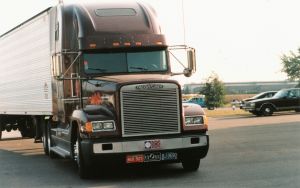How to stop a semi truck in an emergency
To avoid a collision in an emergency situation, if evasive steering isn’t possible then braking becomes the only option left. In general, it’s usually safer to make a quick stop than an evasive turn if there’s enough room to do so. Even if the semi truck cannot be brought to a full stop, the impact of the collision will not be as hard. Professional truck drivers use can use these tips and guidelines for bringing their semi truck to a safe stop.

STEPS
- Push down on the brake pedal firmly. Use the controlled braking method of keeping your foot pushed down steadily on the pedal without letting up. To prevent a skid, do not brake overly hard.
- Most newer semi truck and trailers use anti-locking braking systems (ABS) which should not be stabbed or pumped or fanned. Doing this will cause the system to lose its effectiveness. A light steady application of the brake pedal is best.
- Hold onto the steering wheel firmly with both hands at the 9 o’clock and 3 o’clock positions. Keep the wheel straight without making any turns, if possible.
- If possible, downshift the transmission to use the engine to slow the semi truck down faster. Keep an eye out for an escape path in case you think you won’t stop in time before a collision. If one becomes available and you decide to take it, release your foot off the brake pedal to steer the semi truck in the path that you want to go. Once the truck is going straight again, return to controlled braking until you have come to a complete stop.
TIPS
- Wheels can lock when you apply brakes too hard or suddenly slow down.
- A well-maintained brake system rarely fails completely. Several devices are designed for handling brake failure and preventing accidents. Keep your cool and you can usually bring your rig under control and to a safe stop.
- Brakes fail because of a leak in air pressure, air blockage that usually comes from water freezing in the system, brake fade from overheating, or mechanical failure.
- When driving on a long steep downhill stretch, always be prepared for brake failure.
- Inspect all tires and the air brake system before and during each trip.
WARNINGS
- Braking after a front tire blowout is dangerous because it shifts weight to the front of the vehicle and makes steering more difficult. After the engine has slowed down the rig, it is then safe to gently apply the brakes and pull off the road.
- When holding the steering wheel, it’s safest to keep the thumbs facing up. The force of a tire blowing out can break a thumb wrapped around the steering wheel or under a wheel spoke.
- Never try driving a semi truck after a brake failure without doing a full inspection. Attempting to nurse a truck to the closest technician is not a good idea because of the danger and risks involved.
What did you think of this tutorial?
+ 10
0 CommentsAdd a Comment




